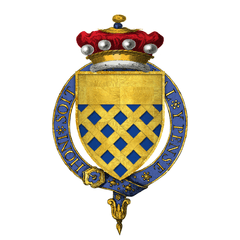Henry FitzHugh, 3rd Baron FitzHugh
| Henry FitzHugh | |
|---|---|
| Chamberlain of the Household | |
| Baron FitzHugh | |
|
In office 1413–1425 | |
| Monarch |
Henry V Henry VI |
| Preceded by | The Lord Grey of Codnor |
| Succeeded by | The Lord Cromwell |
| Treasurer of England | |
|
In office 1416–1421 | |
| Monarch | Henry V |
| Preceded by | Sir Robert Leche |
| Succeeded by | William Kinwolmarsh |
| Personal details | |
| Born | c. 1363 |
| Died | 14 January 1425 |
| Resting place | Jervaulx Abbey, Yorkshire, England |
| Nationality | English |
| Occupation | Administrator and diplomat |

Henry FitzHugh, 3rd Baron FitzHugh KG (c. 1363 – 11 January 1425) was an English administrator and diplomat who served under Henry IV and Henry V.
Royal service
Summoned to parliament in 1388, FitzHugh became active in public affairs following Henry IV's succession. He was engaged in Anglo-Scottish diplomacy, taking part in the Battle of Humbleton Hill in 1402 and negotiating the surrender of his uncle, Archbishop of York Richard le Scrope, in 1405. The next year he travelled to Denmark as part of the escort of Philippa, Henry's daughter, for her marriage to Eric of Pomerania, king of Denmark, Norway and Sweden.[1]
At the coronation of Henry V in 1413, FitzHugh was Constable.[2] During Henry's reign, he served as Chamberlain of the Household (1413–1425, into the reign of Henry VI), and Treasurer of England (1416–1421). He participated in the Battle of Agincourt in 1415 and subsequent diplomacy with the French, which led to the Treaty of Troyes in 1420. He travelled with the king to France, and he escorted the king's remains back to England following his death in 1422. He was an executor of Henry's will and was a feoffee of lands in the will.[1]
He became a Knight of the Garter about 1409.[3]
After his death on 11 January 1425, FitzHugh was buried at Jervaulx Abbey in Yorkshire at his request.[1]
Religion
During his travels to the Scandinavian Peninsula in 1406, he visited the Bridgettine Vadstena Abbey in Sweden, where he volunteered to help establish a Bridgettine community in England, including the promise of a manor at Cherry Hinton in Cambridgeshire. An English order was established in 1415 at Twickenham with the assistance of Henry V.[1][4] He also attended the Council of Constance in 1415.[1]
Family
A descendant of Akarius Fitz Bardolph,[2] FitzHugh was the first son of Hugh FitzHugh, 2nd Baron FitzHugh, and Joan, daughter of Henry Scrope, 1st Baron Scrope of Masham. He married Elizabeth Grey (born c. 1363), daughter of Sir Robert de Grey and his wife, Lora St Quentin. Robert was a son of John de Grey, 1st Baron Grey de Rotherfield and Avice Marmion (a descendant of John, King of England).[5] They had eight sons and six daughters, including:[5]
- William FitzHugh, 4th Baron FitzHugh, married to Margery Willoughby, daughter of William Willoughby, 5th Baron Willoughby de Eresby.[5] They were parents to Henry FitzHugh, 5th Baron FitzHugh who became a brother-in-law to "Warwick, the Kingmaker" by his marriage to Lady Alice Neville; they were great-grandparents to queen consort Catherine Parr.[5]
- Robert FitzHugh, Bishop of London[5]
- Eleanor FitzHugh, who married firstly to Philip Darcy, 6th Lord Darcy of Knayth; they were parents to Elizabeth Darcy, wife of Sir James Strangeways. Eleanor married secondly to Thomas Tunstall and thirdly to Henry Bromflete, 1st Baron Vesci.[5][6]
- Elizabeth FitzHugh, married firstly on 10 December 1427 to Sir Ralph Gray of Chillingham (d.17 March 1442/3) and secondly, in 1445, Sir Edmund Montfort.[5] Her only issue was by her first husband.[5] Elizabeth was a lady-in-waiting to queen consort Margaret of Anjou.[5]
- Maud FitzHugh, wife of Sir William Eure of Witton.[5]
- Laura or Lora FitzHugh, wife of Sir Maurice de Berkeley of Beverstone, Gloucestershire.[7]
References
- 1 2 3 4 5 Reeves, A. C. (January 2008). "Fitzhugh, Henry, third Baron Fitzhugh (1363?–1425)". Oxford Dictionary of National Biography. Oxford University Press. doi:10.1093/ref:odnb/50151. Retrieved 5 June 2011. (subscription or UK public library membership required)
- 1 2 Burke, John (1831). A general and heraldic dictionary of the peerages of England, Ireland, and Scotland, extinct, dormant, and in abeyance. London: Henry Colburn and Richard Bentley. p. 202. Retrieved 30 May 2011.
- ↑ "Knights of the Garter". leighrayment.com. 30 April 2011. Retrieved 5 June 2011.
- ↑ "History of the Bridgettine Order in the UK". Bridgettine Order in the UK. Retrieved 5 June 2011.
- 1 2 3 4 5 6 7 8 9 10 editor, Douglas Richardson ; Kimball G. Everingham,. Plantagenet ancestry : a study in colonial and medieval families (2nd ed.). Salt Lake City, UT.: Douglas Richardson. p. 83. ISBN 9781449966348.
- ↑ Richardson, Douglas (2011). Magna Carta ancestry : a study in colonial and medieval families, Vol II (2nd ed.). Salt Lake City, UT.: Douglas Richardson. p. 27. ISBN 9781449966386.
- ↑ Richardson, Douglas (2011). Magna Carta ancestry : a study in colonial and medieval families, Vol II (2nd ed.). Salt Lake City, UT.: Douglas Richardson. p. 173. ISBN 9781449966386.
| Political offices | ||
|---|---|---|
| Preceded by The Lord Grey of Codnor |
Chamberlain of the Household 1413–1425 |
Succeeded by The Lord Cromwell |
| Preceded by Sir Robert Leche |
Treasurer of England 1416–1421 |
Succeeded by William Kinwolmarsh |
| Peerage of England | ||
| Preceded by Hugh FitzHugh |
Baron FitzHugh 1386–1425 |
Succeeded by William FitzHugh |